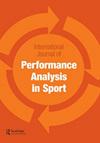2020年奥运会精英水球比赛中全明星球员和获胜球队的关键表现指标
IF 1.6
4区 教育学
Q1 Health Professions
International Journal of Performance Analysis in Sport
Pub Date : 2022-04-03
DOI:10.1080/24748668.2022.2061324
引用次数: 1
摘要
本研究的目的是(i)确定区分全明星和非全明星球员的关键绩效指标,以及(ii)区分2020年东京奥运会男子水球比赛中获胜和平局/输球的球队。样本包括12支球队(156名球员)的所有比赛(n = 42)。使用Mann-Whitney U检验和student-t检验以及二元逻辑回归计算差异。场均出场时间、进球、动作进球、中锋进球、球员外进球、6米进球、点球、抢断和篮板区分了全明星球员和非全明星球员。然而,只有场均出场时间(OR: 1.105)、额外球员进球(OR: 1.748)、6米进球(OR = 3.617)和点球进球(OR: 2.592)被确定为区分全明星球员的指标。关于第二个目标,以下变量区分输球/平局球队:动作进球%,6米进球%,点球进球%,球队犯规%,冲刺获胜,抢断和守门员动作射门%。然而,只有动作进球百分比(OR: 1.153)、抢断百分比(OR: 1.279)和动作射门百分比(OR: 1.093)可以预测比赛结果。教练组可以将这些信息应用于不同的球员,同时考虑到个体差异和功能可变性,以优化训练计划,从而提高个人和团队的比赛表现。本文章由计算机程序翻译,如有差异,请以英文原文为准。
Key performance indicators of all-star player and winning teams in elite water polo at the 2020 Olympic Games
ABSTRACT The aim of this study was (i) to identify the key performance indicators that discriminate all-star from non-all-stars players, and (ii) to differentiate winning from drawing/losing teams during the men´s water polo Olympic Games (Tokyo, 2020). The sample consisted of all matches (n = 42) played by 12 teams (156 players). Differences were calculated using the Mann-Whitney U and student-t tests and the binary logistic regression. Minutes per match, goals, action goals, centre goals, extra-player goals, 6-m goals, penalty goals, steals and rebounds discriminated all-star from non-all-star players. However, only minutes per match (OR: 1.105), extra player goals (OR: 1.748), 6-m goals (OR = 3.617) and penalty goals (OR: 2.592) per time played were determined to differentiate all-star players. Regarding the second aim, the following variables discriminated winning from losing/drawing teams: % action goals, % 6-m goals, % penalty goals, team fouls, sprints won, steals and % goalkeeper actions shots. However, only % action goals (OR: 1.153), steals (OR: 1.279) and % action shots (OR: 1.093) predicted the match outcome. Coaching staffs may apply this information to different players, while account for individual differences and functional variability, to optimise practice planning and, consequently, the game performance of individuals and teams.
求助全文
通过发布文献求助,成功后即可免费获取论文全文。
去求助
来源期刊

International Journal of Performance Analysis in Sport
SPORT SCIENCES-
CiteScore
4.70
自引率
4.80%
发文量
38
审稿时长
>12 weeks
期刊介绍:
The International Journal of Performance Analysis in Sport aims to present current original research into sports performance. In so doing, the journal contributes to our general knowledge of sports performance making findings available to a wide audience of academics and practitioners.
 求助内容:
求助内容: 应助结果提醒方式:
应助结果提醒方式:


